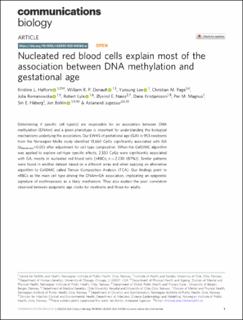| dc.contributor.author | Haftorn, Kristine Løkås | |
| dc.contributor.author | Denault, William Robert Paul | |
| dc.contributor.author | Lee, Yunsung | |
| dc.contributor.author | Page, Christian Magnus | |
| dc.contributor.author | Romanowska, Julia | |
| dc.contributor.author | Lyle, Robert | |
| dc.contributor.author | Næss, Øyvind Erik | |
| dc.contributor.author | Kristjansson, Dana | |
| dc.contributor.author | Magnus, Per Minor | |
| dc.contributor.author | Håberg, Siri Eldevik | |
| dc.contributor.author | Bohlin, Jon | |
| dc.contributor.author | Jugessur, Astanand | |
| dc.date.accessioned | 2024-02-01T13:32:54Z | |
| dc.date.available | 2024-02-01T13:32:54Z | |
| dc.date.created | 2023-03-02T14:01:43Z | |
| dc.date.issued | 2023 | |
| dc.identifier.issn | 2399-3642 | |
| dc.identifier.uri | https://hdl.handle.net/11250/3115081 | |
| dc.description.abstract | Determining if specific cell type(s) are responsible for an association between DNA methylation (DNAm) and a given phenotype is important for understanding the biological mechanisms underlying the association. Our EWAS of gestational age (GA) in 953 newborns from the Norwegian MoBa study identified 13,660 CpGs significantly associated with GA (pBonferroni<0.05) after adjustment for cell type composition. When the CellDMC algorithm was applied to explore cell-type specific effects, 2,330 CpGs were significantly associated with GA, mostly in nucleated red blood cells [nRBCs; n = 2,030 (87%)]. Similar patterns were found in another dataset based on a different array and when applying an alternative algorithm to CellDMC called Tensor Composition Analysis (TCA). Our findings point to nRBCs as the main cell type driving the DNAm–GA association, implicating an epigenetic signature of erythropoiesis as a likely mechanism. They also explain the poor correlation observed between epigenetic age clocks for newborns and those for adults. | en_US |
| dc.language.iso | eng | en_US |
| dc.publisher | Nature | en_US |
| dc.rights | Navngivelse 4.0 Internasjonal | * |
| dc.rights.uri | http://creativecommons.org/licenses/by/4.0/deed.no | * |
| dc.title | Nucleated red blood cells explain most of the association between DNA methylation and gestational age | en_US |
| dc.type | Journal article | en_US |
| dc.type | Peer reviewed | en_US |
| dc.description.version | publishedVersion | en_US |
| dc.rights.holder | Copyright 2023 The Author(s) | en_US |
| dc.source.articlenumber | 224 | en_US |
| cristin.ispublished | true | |
| cristin.fulltext | original | |
| cristin.qualitycode | 1 | |
| dc.identifier.doi | 10.1038/s42003-023-04584-w | |
| dc.identifier.cristin | 2130785 | |
| dc.source.journal | Communications Biology | en_US |
| dc.relation.project | Norges forskningsråd: 262700 | en_US |
| dc.identifier.citation | Communications Biology. 2023, 6, 224. | en_US |
| dc.source.volume | 6 | en_US |

